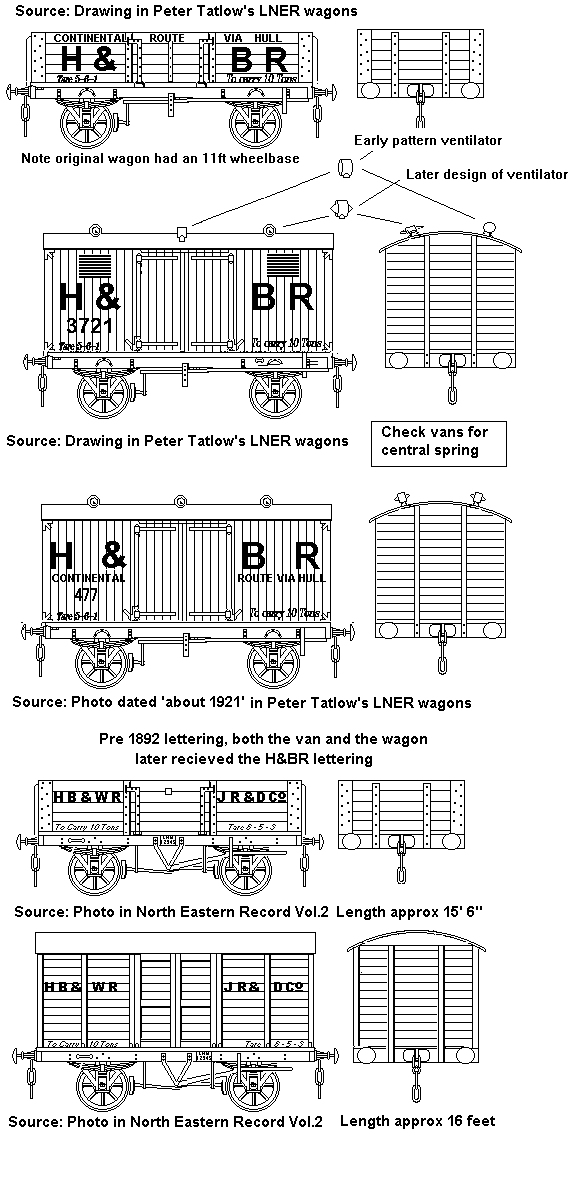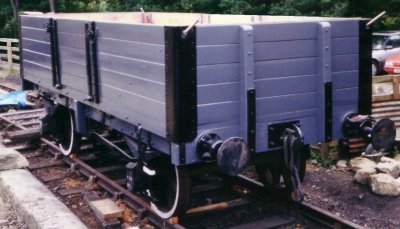
Hull & Barnsley Railway
(Note: Numbers in brackets refer to specific references)
This company started life as the Hull, Barnsley & West Riding Junction Railway & Dock, the official name of the company was shortened to H&BR in June 1905, several years after these initials had appeared on their goods stock. The first part of the line opened in 1885, making it one of the last of the larger independent railway companies to be set up.
The existing docks in Hull were owned by a single company and the NER dominated the rail services in the area. The 66 mile H&BR line was initially built to carry coal from the Yorkshire coal fields to a completely new dock at Hull with both the railway and the new docks supported and promoted by Hull Corporation in an effort to break these monopolies. The H&BR never did manage to reach Barnsley, stopping a couple of miles short at Cadworth where it joined the Midland Railway line. The line to the new docks in Hull was built on a long embankment, crossing roads by more than thirty bridges and this line remains open today. The H&BR had close links with the Midland Railway and the Lancashire & Yorkshire Railway and remained independent until nine months before the 1923 Grouping when it was absorbed by the NER.
Goods stock had lead grey bodies and chassis with black running gear and black body ironwork (2). This company was slightly unusual in that the inside of the wagons was also painted (lead grey) (2), Lettering was white, initially the lettering was H B & W R J R & D Co. on the second plank down on open wagons and the fourth on vans. From 1892 the company initials on the side were shortened to H & B R, originally six inches high on the second plank down but after 1897 higher sided vehicles changed to seventeen inch lettering. Refrigerator vans were white with six inch high black lettering and a black chassis. After 1905 a number of the high sided wagons and vans had 'continental route via hull' in lettering about six inches high along the top of each side. Passenger stock was varnished teak with white roofs and all-black below the solebars, very similar to the Graham Farish LNER coaches. Fitted vehicles, suitable for use in mixed trains such as motor car vans, meat vans and the like were painted in a light brown, to match the teak passenger stock The connecting hoses on fitted stock were black but on piped stock they were red (1).
Fig ___ H&BR

The H B & W R J R & D five plank wagon is a shortened Peco wagon kit with the top plank sanded down to match the rest. The chassis is the Peco kit chassis with a 1mm section removed from each side of the V hanger. The short wheelbase van also runs on a cut down Peco chassis, the body is from the Peco 'ventilated van' kit with the height reduced by 2mm as shown. I think I cut a little too much from the chassis when making this model but it looks like the photograph (1). Both my models are in post 1905 livery.
The H&BR early stock was typical of its day but there were one or two interesting variations on the brake gear used. Later vehicles favoured an eleven foot wheelbase, originally with the long lever and single shoe 'scotch' brake on each side. This makes modelling these wagons quite easy as shown in Sketch XX detailing the five plank open. The brakes were later changed to more conventional Morton pattern, which requires some additional work on the chassis as shown in Sketch XX showing the one-plank open.
Hull & Barnsley Railway 'square timber' wagon in sketch XX has an eleven foot wheelbase. The simple 'scotch' brake (retained into the later 1920's) makes this an easy conversion from a Peco ten foot wheelbase steel chassis. Use a sharp knife to cut down through the brake shoe at the right hand (handle) end and cut away the push-rod from the V hanger to the other brake shoe. Trim away the V hanger itself and cut down through the centre of the chassis. Add two strips of 40x40 thou to the centre to increase the length and add a deck from 1mm scribed card. Fill the side channels with 20x30 thou strip and add brake levers.
The example shown below is the H&BR wagon No 3697 undergoing restoration at Gothland (North Yorks Moors Railway) in August 1999, the photo is courtesy and copyright the Hull and Barnsley Railway Stock Fund
Fig ___ H&BR wagon in preservation

References:
(1) North Eastern Record Vol.2 at Cadworth covers H&BR passenger and goods stock with details of the livery and many useful photographs.
(2) The Hull & Barnsley Railway (Vol.2) edited by B Hinchcliffe Turntable publications
contains comprehensive details of liveries used on goods and passenger stock as well as locomotives. The book covers the early HB & W R J R& D, as well as both the H&BR era and the brief period of NER ownership.
(3) A Pictorial Record of LNER Wagons by Peter Tatlow - OPC - 1976 - ISBN 0 92888 92 7 Contains photographs of an H&BR one plank wagon, and a goods van as well as drawings for a five plank wagon and a second van.
The Hull & Barnsley Railway by G. D. Parkes, published by Oakwood in 1959 offers a commercial history of the line. I have not seen this book.
Societies:
North Eastern Railway Association This site is currently (2018) being updated but the links to the various pages all seem to work.
The NERA also covers the H&BR and has produced, with the HMRS, the North Eastern Record series of books..
H & BR Stock Fund 6 Chequerfield Court, Pontefract, West Yorkshire, WF8 2TO.
(9" x 4" SAE for full details)
The H&BR stock fund was founded to purchase and restore H&BR rolling stock and they have now built up a substantial collection of material relating to the line. No H&BR locomotives survived into preservation but the stock fund has found two coaches, two open wagons, a covered carriage truck and a tool van. The rolling stock, now in the advanced stages of restoration, is all currently hosted at Goathland on the North York Moors Railway Anyone interested in restoration work or in building upon the information on this line should send an SAE to the above address.
Available Models.
No specific models for the H&B freight stock have been found in N Gauge/2mm Scale.
Graham Hughes Kits 20, MacKelvie Road, Lamlash, Isle of Arran Strathclyde KA27 8NP
Mr.Hughes offers white metal kits (including chassis) of the MR 5 plank open, several of which were purchased (second hand) by the H&BR.
Acknowledgements
Considerable thanks are due to Alan Haburn of the H&BRSF for his kind assistance with details of H&BR rolling stock. Thanks are also due to Mike Grocock of the NERA for his assistance in the preparation of this article.